

Compact Muon Solenoid
LHC, CERN
| CMS-PAS-FTR-18-026 | ||
| Predictions on the precision achievable for small system flow observables in the context of the HL-LHC | ||
| CMS Collaboration | ||
| December 2018 | ||
| Abstract: In this note, we discuss how the future HL-LHC program will enable highly precise measurements of flow observables in small systems. Projections of the statistical uncertainties achievable for symmetric cumulant analyses at √s= 13 TeV for pp collisions and at √sNN= 5.02 TeV for pPb collisions are presented. The improvement in the symmetric cumulant precision by increasing the pp beam energy to 14 TeV, while extending the CMS tracker pseudorapidity coverage to |η|< 4, is also shown. In addition, we show how the HL-LHC will allow for elliptic flow measurements of D0 and J/ψ mesons in 8.16 TeV pPb collisions that are a factor of two more precise than currently possible. | ||
| Links: CDS record (PDF) ; inSPIRE record ; CADI line (restricted) ; | ||
| Figures | |

png pdf |
Figure 1:
SC(2,3) as a function of total multiplicity in pp collisions at 13 TeV (left) and pPb collisions at 5.02 TeV (right). Only statistical uncertainties are displayed. The open circles show the current CMS results standard 4-particle cumulant method [2]. The vertical dashed line shows the multiplicity range above which data were collected using a high-multiplicity trigger. The color-shaded areas show the HL-LHC projections for 2-, 3- and 4-subevent symmetric cumulant analyses, as indicated. |

png pdf |
Figure 1-a:
SC(2,3) as a function of total multiplicity in pp collisions at 13 TeV (left) and pPb collisions at 5.02 TeV (right). Only statistical uncertainties are displayed. The open circles show the current CMS results standard 4-particle cumulant method [2]. The vertical dashed line shows the multiplicity range above which data were collected using a high-multiplicity trigger. The color-shaded areas show the HL-LHC projections for 2-, 3- and 4-subevent symmetric cumulant analyses, as indicated. |
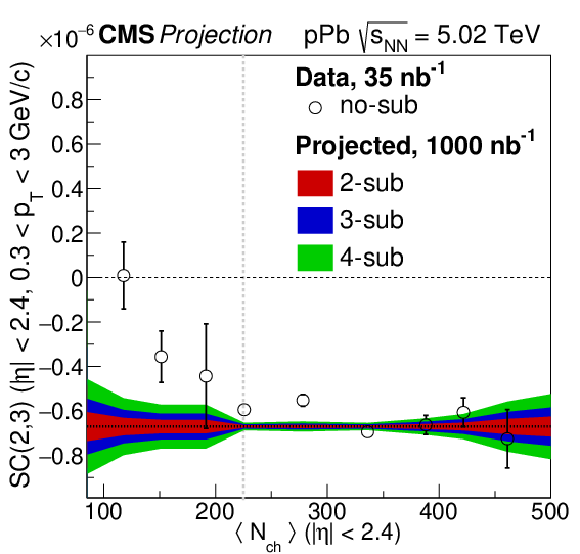
png pdf |
Figure 1-b:
SC(2,3) as a function of total multiplicity in pp collisions at 13 TeV (left) and pPb collisions at 5.02 TeV (right). Only statistical uncertainties are displayed. The open circles show the current CMS results standard 4-particle cumulant method [2]. The vertical dashed line shows the multiplicity range above which data were collected using a high-multiplicity trigger. The color-shaded areas show the HL-LHC projections for 2-, 3- and 4-subevent symmetric cumulant analyses, as indicated. |
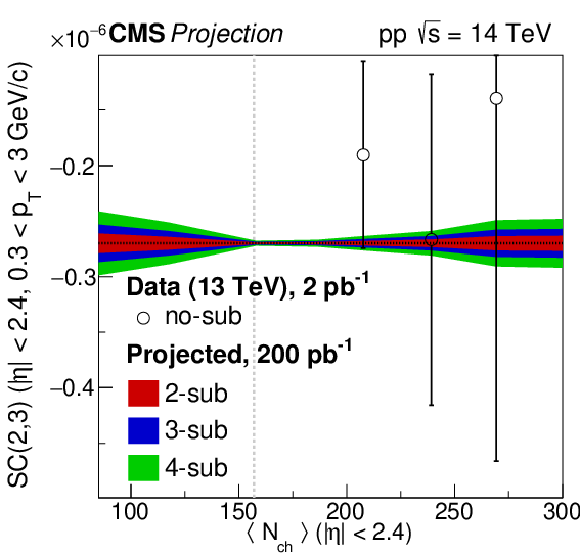
png pdf |
Figure 2:
SC(2,3) as a function of total multiplicity in pp collisions at 14 TeV. Only statistical uncertainties are displayed. The vertical dashed line shows the multiplicity range above which data were collected using a high-multiplicity trigger. The open circles are the current CMS results at 13 TeV [2]. The color-shaded areas show the HL-LHC projections for 2-, 3- and 4-subevent symmetric cumulant analyses, as indicated. |

png pdf |
Figure 3:
SC(2,3) as a function of total multiplicity in pp collisions at 13 and 14 TeV using the 3-subevent method. Only statistical uncertainties are displayed. The open circles show the current CMS results using the standard 4-particle cumulant method [2]. The vertical dashed line shows the multiplicity range above which data were collected using a high-multiplicity trigger. The blue shaded area is the projection for the current CMS tracker acceptance and the gray shaded area is the projection for CMS extended tracker acceptance. |
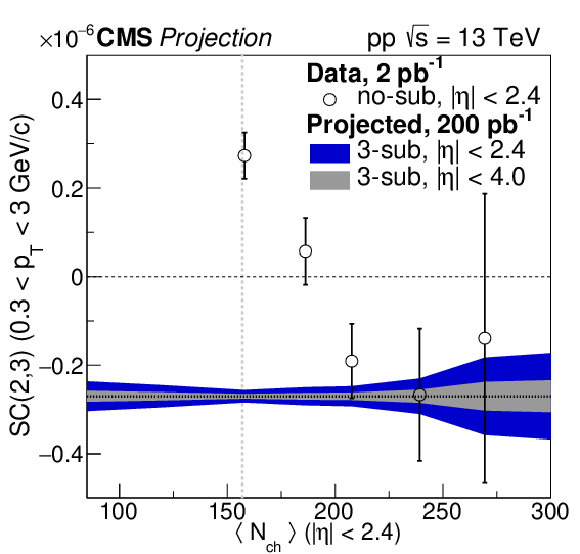
png pdf |
Figure 3-a:
SC(2,3) as a function of total multiplicity in pp collisions at 13 and 14 TeV using the 3-subevent method. Only statistical uncertainties are displayed. The open circles show the current CMS results using the standard 4-particle cumulant method [2]. The vertical dashed line shows the multiplicity range above which data were collected using a high-multiplicity trigger. The blue shaded area is the projection for the current CMS tracker acceptance and the gray shaded area is the projection for CMS extended tracker acceptance. |
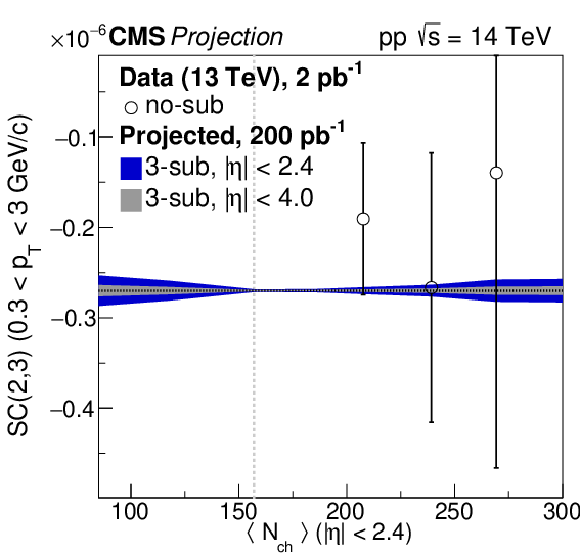
png pdf |
Figure 3-b:
SC(2,3) as a function of total multiplicity in pp collisions at 13 and 14 TeV using the 3-subevent method. Only statistical uncertainties are displayed. The open circles show the current CMS results using the standard 4-particle cumulant method [2]. The vertical dashed line shows the multiplicity range above which data were collected using a high-multiplicity trigger. The blue shaded area is the projection for the current CMS tracker acceptance and the gray shaded area is the projection for CMS extended tracker acceptance. |

png pdf |
Figure 4:
(Left) HL-LHC projections for D0 and J/ψ elliptic flow as a function of pT. (Right) Elliptic flow projections scaled by the number of constituent quarks (nq) as a function of the similarly scaled transverse kinetic energy (KET/nq). Only statistical uncertainties are displayed. |

png pdf |
Figure 4-a:
(Left) HL-LHC projections for D0 and J/ψ elliptic flow as a function of pT. (Right) Elliptic flow projections scaled by the number of constituent quarks (nq) as a function of the similarly scaled transverse kinetic energy (KET/nq). Only statistical uncertainties are displayed. |
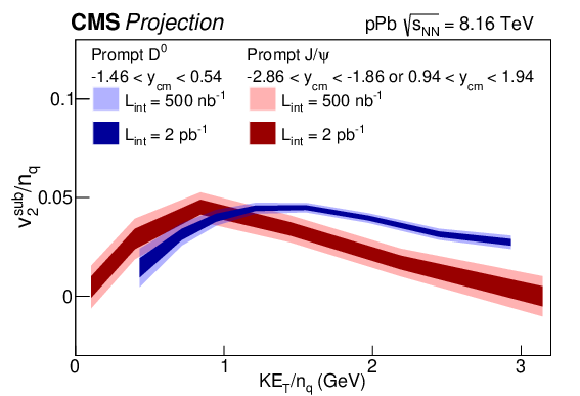
png pdf |
Figure 4-b:
(Left) HL-LHC projections for D0 and J/ψ elliptic flow as a function of pT. (Right) Elliptic flow projections scaled by the number of constituent quarks (nq) as a function of the similarly scaled transverse kinetic energy (KET/nq). Only statistical uncertainties are displayed. |
| Summary |
| In this note, we have presented projections for symmetric cumulant and heavy particle elliptic flow analyses in the context of the HL-LHC. The increase of luminosity significantly reduces the experimental uncertainties compared to existing results. Such measurements will provide a better understanding of the "ridge'' structure observed in small colliding system. In terms of its theoretical understanding, this is among the most controversial behaviors found in relativistic heavy-ion collisions. |
| References | ||||
| 1 | F. Wang | Novel Phenomena in Particle Correlations in Relativistic Heavy-Ion Collisions | Prog. Part. NP 74 (2014) 35--54 | 1311.4444 |
| 2 | CMS Collaboration | Observation of Correlated Azimuthal Anisotropy Fourier Harmonics in pp and p+Pb Collisions at the LHC | PRL 120 (2018), no. 9, 092301 | CMS-HIN-16-022 1709.09189 |
| 3 | CMS Collaboration | Elliptic flow of charm and strange hadrons in high-multiplicity pPb collisions at √sNN= 8.16 TeV | PRL 121 (2018), no. 8, 082301 | CMS-HIN-17-003 1804.09767 |
| 4 | CMS Collaboration | Measurement of correlated azimuthal anisotropy Fourier harmonics with subevent cumulants in pPb collisions at 8.16 TeV | CDS | |
| 5 | CMS Collaboration | Observation of prompt J/ψ meson elliptic flow in high-multiplicity pPb collisions at √sNN= 8.16 TeV | Submitted to: PL(2018) | CMS-HIN-18-010 1810.01473 |
| 6 | CMS Collaboration | The CMS Experiment at the CERN LHC | JINST 3 (2008) S08004 | CMS-00-001 |
| 7 | CMS Collaboration | Technical Proposal for the Phase-II Upgrade of the CMS Detector | CMS-PAS-TDR-15-002 | CMS-PAS-TDR-15-002 |
| 8 | CMS Collaboration | The Phase-2 Upgrade of the CMS Tracker | CDS | |
| 9 | CMS Collaboration | The Phase-2 Upgrade of the CMS Barrel Calorimeters Technical Design Report | CDS | |
| 10 | CMS Collaboration | The Phase-2 Upgrade of the CMS Endcap Calorimeter | CDS | |
| 11 | CMS Collaboration | The Phase-2 Upgrade of the CMS Muon Detectors | CDS | |
| 12 | CMS Collaboration | CMS Phase-2 Object Performance | ||
| 13 | ATLAS Collaboration | Correlated long-range mixed-harmonic fluctuations in pp, p+Pb and low-multiplicity Pb+Pb collisions with the ATLAS detector | ATLAS-CONF-2018-012, CERN, Geneva, May | |

|
Compact Muon Solenoid LHC, CERN |

|

|

|

|

|

|